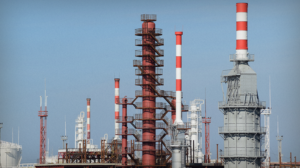 Distillation is an essential process for the chemical process industries. If you haven’t already read Part 1 and Part 2 of this series, we recommend reading this information for a more thorough understanding of tower internals and reboilers.
Distillation is an essential process for the chemical process industries. If you haven’t already read Part 1 and Part 2 of this series, we recommend reading this information for a more thorough understanding of tower internals and reboilers.
The final part of our distillation series will examine special situations that may occur through the course of the distillation. Although these situations may not be applicable for every CPI application, it’s important to examine them closely so that you’re ready for whatever comes your way. Discover three special topics in distillation that can affect the success of your process, or cause you difficulties if you’re unprepared.
Azeotropic Distillation
An azeotrope or a constant boiling mixture is composed of two or more liquids whose proportions cannot be altered by simple distillation. Sometimes, no matter what you do, only a certain amount of purity can be obtained from the distillation process, a classic example of which is the water-ethanol mixture. When you operate at ambient pressure, the highest level of purity you can possibly achieve is 95 percent, which cannot be changed without altering the distillation process.
If you absolutely must have a higher purity level, you should consider using the azeotropic distillation process. Azeotropic distillation employs techniques like pressure-swinging or the addition of a compound that breaks the azeotrope or water dehydration in order to increase the purity of the distillate, which can sometimes reach a purity level of 99+ percent.
Vacuum vs. Atmospheric Distillation
Distillation is generally thought of as a process that requires heat to be accomplished successfully. However, there is actually an alternative where less heat is added to the process. You can lower the column operating pressure in the tower which lowers the boiling point of the liquid. The technique is useful when the compound being distilled thermally degrades at a high temperature.
Atmospheric distillation is performed at or near atmospheric pressure. The temperature of the liquid is slowly raised to bring it to a boil and the compounds of interest are collected in their vapor state and condensed at the top of the column with a condenser. Performing atmospheric distillation generally requires use of a reboiler, overhead condenser and other necessary equipment.
Tower operating pressure is determined most often by the temperature of the available condensing medium, 100-120 °F if cooling tower water is used; or by the maximum allowable reboiler heating media temperature, 150 psig steam, 366 °F.
Vacuum distillation is appropriate where the components being separated are heat sensitive. Vacuum distillation can also be used to lower the initial boiling point below your saturated steam temperature so the steam supply you have on hand can be used instead of having to install a hot oil system. For example let’s say we have 150 psig steam on hand that has a saturated temperature of 366 ℉. The initial boiling point of the material to be distilled is above this temperature of 366 ℉. If we can lower the pressure in the column to a Boiling Point value that corresponds to say 316 ℉ then the existing 150 psig steam in the plant can be used and we have 50 ℉ of driving force in the reboiler.
While vacuum distillation may reduce the use of excess heat, some processes still require elevated temperatures along with the decreased pressure, there is still the need to have your distillation tower capable of holding a vacuum. Our firm has used Freon 134a from an electronic spray cleaner and a Freon detector to find vacuum leaks in small distillation systems.
Reactive Distillation
Finally, reactive distillation is a process that can be used with reversible liquid phase reactions. In this process, the reactor and the distillation column are one and the same, allowing one of the products to be removed continuously to prevent migration back to the reactants.
For example, think of a simple process where two reactants, A and B, yield two products, Y and Z. The chemical equilibrium equation has an equal transfer of products to reactants. Some processes are tilted to one side or the other.
In the case where reactants become products, instead of the reverse, you can slow down the process considerably by removing one. In our case, removing Z will slow the reverse reaction down and allow us to collect Y as a product. Care must be taken with reactive distillation that the reactants don’t boil before the products do.
Catalysts can be coated on structured packing or placed in fiberglass cloth pillows in trayed columns.
COSTELLO Has the Expertise for These and Other Special Topics in Distillation
Do you have a unique process that you would like us to simulate or help you design? Contact Costello’s team of expert engineers today to get started.
Check out part 1 and part 2 here!
Phone: 310-792-5870 Email: rcca@rccostello.com
Website: rccostello.com